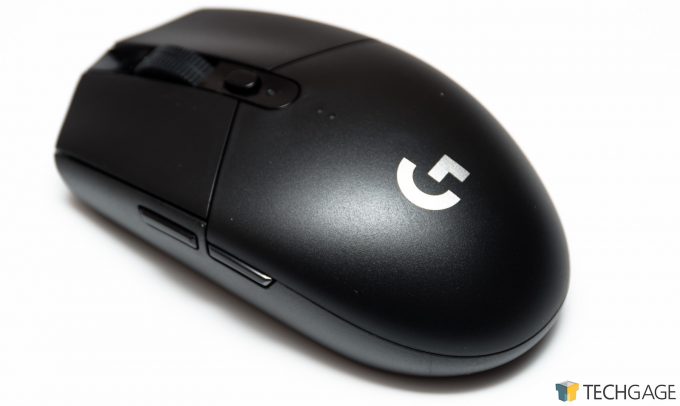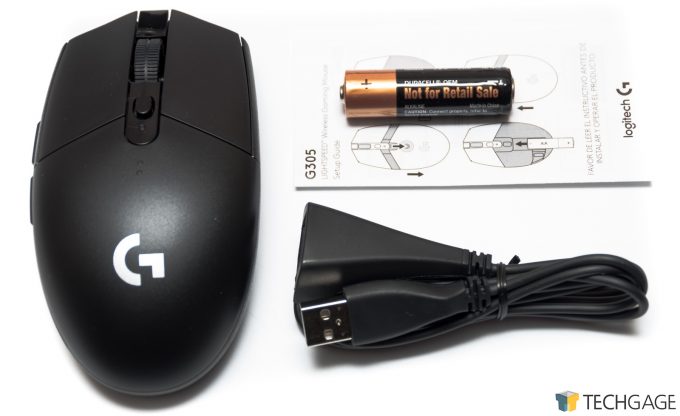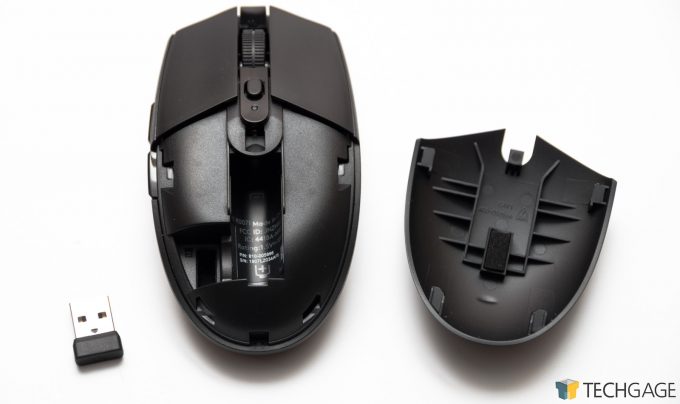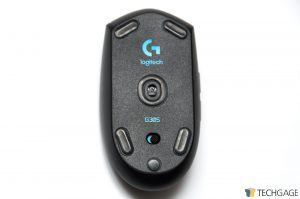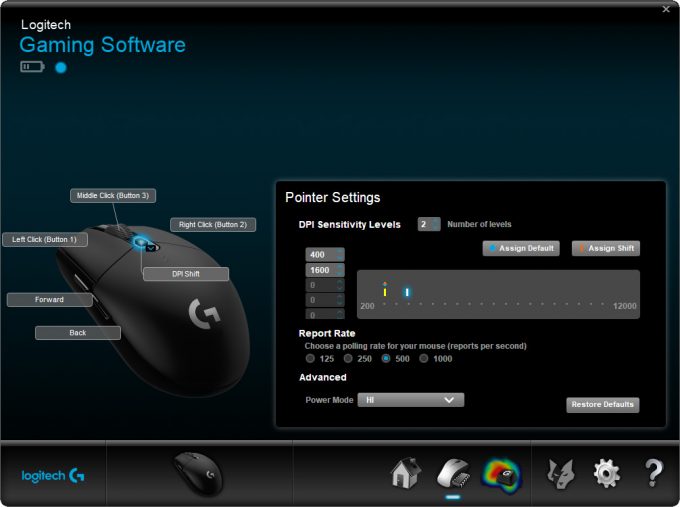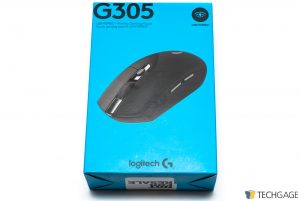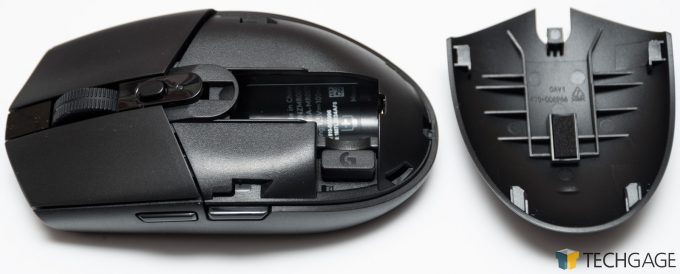- Qualcomm Launches Snapdragon 4 Gen 2 Mobile Platform
- AMD Launches Ryzen PRO 7000 Series Mobile & Desktop Platform
- Intel Launches Sleek Single-Slot Arc Pro A60 Workstation Graphics Card
- NVIDIA Announces Latest Ada Lovelace Additions: GeForce RTX 4060 Ti & RTX 4060
- Maxon Redshift With AMD Radeon GPU Rendering Support Now Available
A Cheap Wireless Mouse That Doesn’t Suck: Logitech G305 LIGHTSPEED Review

Wireless mice are one of those things that rarely meets expectations, but Logitech seems to have cracked it with its LIGHTSPEED mice. The G305 under review today might be on the low-end, but we soon find out it’s a solid performer with an absurd battery life. Dig in for more details.
Wireless mice have been sold for decades, and these have often been acceptable for office work. Gamers on the other hand, don’t like office mice, they want the best of the best, all the time.
So for many years we got just that, super high-end wireless gaming mice with all the bells and whistles of their wired counterparts, but without the cord, and for many, it was bliss – until 12 hours later when you had to plug the damn thing in to charge.
I don’t know who thought a 12 hour battery life was a good idea on a mouse, but apparently, many people bought them, and still continue to do so. When a wireless mouse spends half its time plugged in, is it really wireless at that point?
Logitech made a rather impressive wireless mouse a few years ago with the M705 Marathon Mouse, which had a staggering three-year battery life – but it was a productivity mouse with limited DPI settings, an off-center sensor, and required the poll-rate to be set to 125Hz – but the free-scroll was nice. Also the two batteries in it did make it a bit heavy – but not once did I ever feel battery anxiety.
Today though, technology has progressed, and not only are there more features to consider, but power efficiency too. Logitech’s G305 LIGHTSPEED is a lightweight gaming mouse. It features Logitech’s well-regarded HERO sensor at a rather absurd 12000 DPI (which is nothing new these days), can use the full 1000Hz poll rate, and last 3-9 months. In its full power mode, it has a 250 hour operational life, from a single AA battery.
After a month of continuous use at 8+ hours a day, there is still plenty of life left – my thinking is that these battery life figures are very real, even if a bit conservative. But I’m getting ahead of myself a bit here.
The Hardware & Software
The G305 is a very unassuming mouse, very basic and simple. It has six-buttons, a symmetrical shape, but the button layout is for right-handed users. There is no charging port, and the battery is in a compartment under the palm rest, which is also used to store the nano receiver. That’s it. This really is a no-nonsense design.
It looks simple, but it feels very precise. There is no slop or give, solid plastics, everything fits together perfectly. The buttons are sharp, tactile, and precise. The battery can be exposed and changed with one hand as well. The scroll wheel is just as sharp as the buttons too. Solid, sharp, precise, what more can you ask for?
The HERO sensor used by all of Logitech’s G-series mice, is regarded as one of, if not the best in the industry. It’s really accurate, it has no smoothing or filtering, it’s very fast and efficient, and uses very little power. The sensor can even be flashed with new firmware independently of the microcontroller, should Logitech come up with a better method for motion detection, working with different surface materials and such.
Because the mouse uses AA batteries, it is a bit heavier than if it were to use a rechargeable lithium cells. However, Logitech does recommend people use the AA Lithium batteries that are available, as those will not only extend the already long battery life, but also reduce the weight of the already light mouse.
Dropping the mouse from 1000 Hz poll rate down to 500 Hz can further extend the battery life, with pretty much no loss in performance. The mouse wakes up from its sleep mode extremely quickly, even after extended off-time. After a month of using the G305, I have actually forgotten that it’s even a wireless mouse.
While going over a lot of the details and tech used by the mouse, I did have a number of questions pop up which I pinged Logitech about, namely about a small graphic about keeping the receiver 20cm away from the mouse. My initial thought was that this related to some kind of power saving feature. With Bluetooth for example, when devices are close together, they can drop into a low power state to increase battery life.
It turns out this isn’t what Logitech does. Instead, the proximity of the sensor is purely to prevent interference – since it uses the very congested 2.4GHz range. However, it doesn’t mean the sensor has to be 20cm away, it works perfectly over several meters if you like to use the big-screen TV for gaming.
All of Logitech’s wireless mice make use of the same power management system. Low and high power modes directly relate to the poll rate of the USB bus. Low power mode sets the poll rate to a fixed 125Hz rate, while high power lets you set it to 250, 500 or 1000Hz, with each increase making the mouse a bit more responsive, but using more power in the process. This can all be controlled by the software.
Most will be able to tell the difference between 1000 and 125 Hz if they went looking, but going from 1000 to 250 or 500, requires very specific tests and a good eye. One of the main reasons for this is the simple fact that there are many more factors involved in the response time of a user input that goes well beyond the poll rate of the USB bus. When reacting to a click in a game can take 5-10ms, and a frame from the GPU can take 8-30ms, the 1-4ms from the poll rate is basically nothing.
Logitech’s software is pretty simple to use too, and has been the gold standard for peripherals. Things are kept straight-forward and easy to follow, with less focus on gimmicks, and more on usability. You can use a single profile that’s stored on the mouse, or use the software mode and have the mouse change based on what game or application is launched. However, with 6 buttons to pick from on the G305 and no RGB options, there isn’t really a huge need for such diverse software apart from the initial setup, at least for this G305.
The most important parts with DPI selection, poll, and power rate, can all be assigned from the same menu. The action for the top button to cycle through DPI modes is default, but it doesn’t take long to set it up to flick through just two DPI modes as a ‘snipe’ button, or with simple high, medium, and low DPI levels to flick through. The only thing it doesn’t let you do is set independent X and Y-axis DPI levels.
Final Thoughts
This is one of those odd occasions where there is very little else to talk about. The mouse ‘just works’ and it’s pretty simple to use. It doesn’t need 40 buttons and absurd configurations, nor a labyrinth of options to set custom lighting since there is, for once, no RGB.
The G305 is a wireless mouse with all the precision of a gaming mouse, and battery life that won’t leave you anxious. The only bit of bling about this mouse is a single blue LED (not the super bright kind) that lights up when it wakes from sleep mode and turns itself off after a couple of seconds. When the battery gets low, it’ll blink red to let you know (the software will push notifications through to Windows too).
The battery level indicator in the software is a little bit off in that it’ll stay at max for quite a long time, and then before you know it, it’s at 50% then 30% within a couple of days. This is fairly typical though, as accurate battery level detection is based on voltage, and can vary quite a lot based on battery type.
A rechargeable NiMh would likely show 50% charge for weeks, while a lithium AA will show as full until there’s only a day or so left. The benefit of using a single AA battery means you will typically always have a spare lying around somewhere, since they come in pairs.
The low battery warning does get a bit obnoxious and nagging, with Windows 10 popping up warnings starting at 30% every other time you wake the computer up from power save. And with the supplied AA battery, it’ll stay at 30% for over a week before dropping down to 20%. Even though the software nags a lot, there is usually a fair amount of battery life left, even as it reaches 10% or so.
As part of a long-term look at this G305 LIGHTSPEED, I can definitely say that 3 months of battery life is quite achievable, as it’s been that long since we got sampled, and the battery has approximately 15% life left. This is from being used every single day for 6-12 hours at a poll rate of 500Hz. The mouse has remained in good shape and there has only been minor cosmetic damage where part of the G logo on the back of the palm rest has faded.
The lack of a wired connection may be inconvenient for some, but this mouse really doesn’t need one, and it saves some cost on the product too. Speaking of cost, at under $60, this is a pretty cheap wireless gaming mouse. It’s not the cheapest wireless mouse, but it’s certainly one of the better ones. If you don’t mind some extra weight, there is always the slightly higher-end G603 which allows for a pair of AA batteries, doubling the life of the mouse (since the batteries are in parallel) for not much more of a price premium. The G305 might be on the low-end, but it features an absurd battery life, precise and solid build quality, and practically no latency.
Support our efforts! With ad revenue at an all-time low for written websites, we're relying more than ever on reader support to help us continue putting so much effort into this type of content. You can support us by becoming a Patron, or by using our Amazon shopping affiliate links listed through our articles. Thanks for your support!




